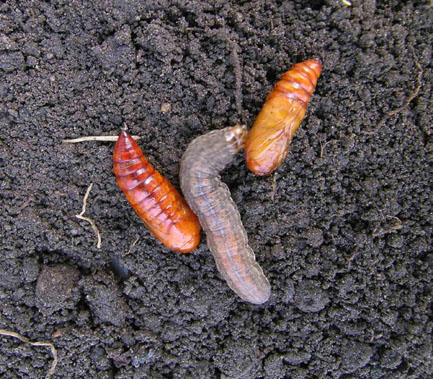Manitoba Insect and Disease Update: June 18, 2013
Compiled by:
- John Gavloski, Entomologist
Manitoba Agriculture, Food and Rural Initiatives
Phone: (204) 745-5668
Fax: (204) 745-5690. - Holly Derksen, Plant Pathologist
Manitoba Agriculture, Food and Rural Initiatives
Phone: (204) 750-4248
Fax: (204) 745-5690
To report observations on insects or plant pathogens that may be of interest or importance to farmers and agronomists in Manitoba, please send messages to the above contact address.
To be placed on an E-mail list so you will be notified immediately when new Manitoba Insect and Disease Updates are posted, please contact John Gavloski at the address or numbers listed above.
Recent Insect and Plant Pathogen Activity
Flea Beetles in Canola
Flea beetle populations have been at levels requiring insecticide applications in canola fields across Manitoba over the past week. Some fields have had more than 1 application. There has been some reseeding of canola in the Central and Southwest regions due to feeding by flea beetles and other issues resulting in thin stands.
When canola gets to the 3 to 4 leaf stage in most instances it will be able to compensate for the feeding by flea beetles. Later seeded fields will still need to be monitored for flea beetle feeding.
Cutworms
Damage from and control of cutworms has been reported from fields in all agricultural regions of Manitoba. In some instances damage is in patches, in other instances whole fields are affected. If it is determined that damage is in specific patches or a specific area of the field, just treatinfg affected patches is sometimes all that is needed. Size of the cutworms will depend on the species. Our most common species will get to about 38 mm (1.5 inches) before that stop feeding and turn into pupae. So in fields where you are finding cutworms, assess the size of the cutworms as well to determine if there is much feeding time left. The following photo shows a redbacked cutworm larva (middle) and 2 redbacked cutworm pupae.

Wireworms
Damage from wireworm has been reported in some wheat, corn and soybean fields. Some winter wheat in the Eastern region was reseeded because of wireworm feeding. Seed treatments can help prevent wireworms from feeding on crops, but current seed treatments do not result in high levels of mortality of wireworms. There are no methods of managing wireworms once a crop is seeded. It is good to take note of fields that currently have higher wireworm levels, as the larvae spend more than one year in the soil before emerging as a beetle. The number of years as a larva in the soil depends on the species. Knowing which fields have higher wireworm levels can help when planning crops and seed treatments for a field the next year.
Grasshoppers
Grasshoppers are emerging, and some higher levels have been reported along the edges and borders of some fields in the Northwest and Eastern regions. When looking for grasshoppers, begin by scouting the field margins and areas that had lush green vegetation late last summer. This is often where populations originate. Young grasshoppers will not have wings and cannot fly, so movement into fields this time of year is gradual. If populations are quite high along these field margins, and it looks like control may be needed, wait until many of the grasshoppers have grown into their third (out of 5) stage of growth as a nymph . At this stage the grasshoppers still cannot fly, and most of the eggs would have hatched. Bran baits as well as foilar sprays are available for grasshopper management.
Surveys and Forecasts
Diamondback moth
Trap counts are high in the Eastern part of Manitoba. Highest trap counts are:
| Location | Count from previous week | Total Count |
|---|---|---|
| Steinbach | 373 | 578 |
| Oldenburg | 123 | 269 |
| Beausejour | 68 | 164 |
| Springwell | 113 | 144 |
| River Hills | 100 | 115 |
| Morris | 106 | |
| St. Elizabeth | 81 |
All of the counts in the table above are from traps in Eastern Manitoba.
The highest count from a trap in Central Manitoba is 61 from a trap near Carman.
The highest counts from traps in Western Manitoba are
The Pas - 44
Diurban - 20
Miniota - 12
So far there are no reports of larvae of diamondback moth being found. The high adult counts in some of the traps indicate that looking for larvae of diamondback should be considered a priority when scouting fields, but are not an indication that higher levels of larvae will occur. High adult numbers in traps do not always result in high levels of larvae. Natural enemies, weather, or a combination of these factors can keep levels of larvae low.
